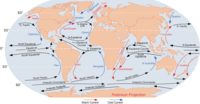
Photo from wikipedia
Abstract Precipitation extremes have a strong influence on the exchange of energy and water between the land surface and the atmosphere. Although the Horn of Africa has faced recurrent drought… Click to show full abstract
Abstract Precipitation extremes have a strong influence on the exchange of energy and water between the land surface and the atmosphere. Although the Horn of Africa has faced recurrent drought and flood events in recent decades, it is still unclear how these events impact energy exchange and surface temperature across different ecosystems. Here, we analyzed the impact of precipitation extremes on spectral albedo (total shortwave, visible, and near-infrared (NIR) broadband albedos), energy balance, and surface temperature in four natural vegetation types: forest, savanna, grassland, and shrubland. We used remotely sensed observations of surface biophysical properties and climate from 2001 to 2016. Our results showed that, in forests and savannas, precipitation extremes led to divergent spectral changes in visible and NIR albedos, which cancelled each other limiting shortwave albedo changes. An exception to this pattern was observed in shrublands and grasslands, where both visible and NIR albedo increased during drought events. Given that shrublands and grasslands occupy a large fraction of the Horn of Africa (52%), our results unveil the importance of these ecosystems in driving the magnitude of shortwave radiative forcing in the region. The average regional shortwave radiative forcing during drought events (−0.64 W m−2, SD 0.11) was around twice that of the extreme wet events (0.33 W m−2, SD 0.09). Such shortwave forcing, however, was too small to influence the surface–atmosphere coupling. In contrast, the surface feedback through turbulent flux changes was strong across vegetation types and had a significant (P
Journal Title: Agricultural and Forest Meteorology
Year Published: 2020
Link to full text (if available)
Share on Social Media: Sign Up to like & get
recommendations!